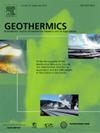Effects of thermal loading conditions on the thermo-mechanical response of energy pile at different depths
IF 3.9
2区 工程技术
Q3 ENERGY & FUELS
引用次数: 0
Abstract
This paper investigates the thermo-mechanical response of a full-scale energy pile under different thermal loading conditions at a field site in Liyang City, Jiangsu Province. The results show that a 1 °C increase in inlet temperature during heating led to a rise from 0.33 °C to 0.74 °C in pile temperature, while a 1 °C decrease during cooling caused a drop of 0.65 °C to 2.10 °C. Additionally, the ratio of the pile temperature change to the theoretical maximum pile temperature change remained consistent across different inlet temperatures, indicating a fixed temperature response sensitivity of the pile to inlet temperature variations. The most significant temperature change occurred in the middle part of the pile, where the thermal strain was minimal due to the greatest soil and structural constraints, leading to the highest thermal stress. In contrast, the smallest temperature change and thermal stress were observed at the bottom of the pile. Besides, the average compressive stress under the intermittent heating operation was 37.9 % lower than under the continuous heating operation, while the average tensile stress under intermittent cooling decreased by 63.3 %. By providing different field data on the thermo-mechanical behavior of the energy pile under various thermal loading conditions, this study is beneficial for the design and operation of energy pile systems.
热载荷条件对不同深度能量桩热-力响应的影响
本文研究了江苏溧阳市某现场全尺寸能源桩在不同热载荷条件下的热-力学响应。结果表明:加热时进口温度每升高1℃,桩温从0.33℃升高到0.74℃;冷却时进口温度每降低1℃,桩温从0.65℃下降到2.10℃。此外,在不同入口温度下,桩温变化与理论最大桩温变化之比保持一致,说明桩对入口温度变化的温度响应敏感性是固定的。桩中部温度变化最显著,由于土体和结构约束最大,此处热应变最小,热应力最大。而桩底温度变化和热应力最小。间歇加热条件下的平均压应力比连续加热条件下降低了37.9%,间歇冷却条件下的平均拉应力降低了63.3%。通过提供不同热载荷条件下能源桩热力学行为的不同现场数据,有助于能源桩系统的设计和运行。
本文章由计算机程序翻译,如有差异,请以英文原文为准。
求助全文
约1分钟内获得全文
求助全文
来源期刊

Geothermics
工程技术-地球科学综合
CiteScore
7.70
自引率
15.40%
发文量
237
审稿时长
4.5 months
期刊介绍:
Geothermics is an international journal devoted to the research and development of geothermal energy. The International Board of Editors of Geothermics, which comprises specialists in the various aspects of geothermal resources, exploration and development, guarantees the balanced, comprehensive view of scientific and technological developments in this promising energy field.
It promulgates the state of the art and science of geothermal energy, its exploration and exploitation through a regular exchange of information from all parts of the world. The journal publishes articles dealing with the theory, exploration techniques and all aspects of the utilization of geothermal resources. Geothermics serves as the scientific house, or exchange medium, through which the growing community of geothermal specialists can provide and receive information.
 求助内容:
求助内容: 应助结果提醒方式:
应助结果提醒方式:


